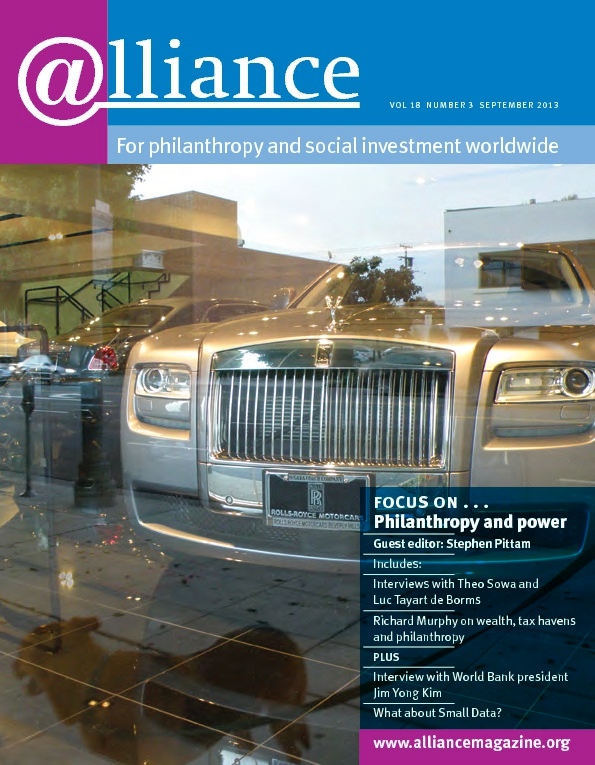There’s a new phenomenon in philanthropy that would hardly have been recognized 15 years ago: the belief that the best way to support development is to find what works and then roll it out big time, almost like a McDonalds franchise. Whereas in the past a foundation might have piloted an idea and then expected government to take it up – with a degree of democratic accountability – now some foundations have the resources to roll programmes out themselves.
Inherent in this approach is the idea that you can ‘do development to people’. The power relations are firmly tilted towards the funder. Local people and organizations have a role as implementers, but they don’t contribute to the design and have little power over the whole project. The same phenomenon is found increasingly among international donors, where aid is ‘transactionalized’: the donor selects the outputs and provides money in exchange for these being delivered. Local organizations are again the implementers of something they may have had little or no hand in shaping.[1]
By contrast, the Local First initiative, of which Peace Direct was a founder member, starts from the view that development has to be locally led, with decision-making power firmly in the hands of local actors. The initiative distinguishes between three ways of working with locals:
• Locally led, where the local partner formulates the approach and the outside agency provides, for example, resources and connections.
• Locally owned, where the approach comes from outside but there is a determined effort to transplant the ownership of the work to a legitimate local organization.
• Locally delivered, or implemented, where the approach comes from outside and an organization is chosen to implement it, with little or no role in design.
On grounds of equity, we believe the people who will gain or lose from a development initiative should have a large say in how the initiative is designed. But there are also practical arguments in favour of local leadership rather than local delivery. First, context matters. Even between two apparently similar situations – for example demobilization and reintegration in postwar DRC and postwar South Sudan – the differences are sufficiently great that what works in one may not work in the other. The level and nature of social capital, the degree of distrust between tribal groups, the presence or absence of strong religious leaders in favour of peace – these and many other factors can make the difference between success and failure.
Second, sooner or later, the funding for the project comes to an end. If there has been no local involvement in choosing and shaping the project and providing resources, then it is more likely that several years after the funding ends, there will be little to show for it.
How then to reconcile the legitimate and indeed laudable desires of ‘franchise philanthropy’ – to work at scale, to aggregate outputs and to add value to the development process – with local leadership of development?
Perhaps one answer lies in the way the Foyer Federation[2] operated. The Foyer model was imported from France, where it supported large-scale migration from rural to urban France after the Second World War by providing young people with housing and vocational training. Transplanted to the UK in the early 1990s, Foyers provided a solution to the ‘no home – no job – no home’ cycle.
In a period of 12 years, 130 Foyers were developed across the UK, serving about 10,000 young people each year. Each was a local decision, made by a partnership of housing provider, social services, education, criminal justice, and others. Each responded to local needs, ranging from a 4-bed project in rural Wales to a 120-bed project in East London. Each required a lot of voluntary effort, particularly at the beginning. They all raised their own funds and were responsible for their own upkeep.
However, the federation provided a lot of technical support and encouraged an ethos of sharing through an accreditation system. Because all the Foyers were doing the same job, comparisons between individual Foyers and the provision of peer support between them was possible. In effect it was a ‘soft franchise.’
Perhaps this is a model that donors might consider? By all means, decide on what you want to achieve and bring in a range of ideas, and allow organizations to visit and share experiences. But give the ultimate power to decide how best to achieve your goals to a local consortium that can mobilize voluntary effort from the community to get the initiative off the ground and sustain it.
1 See Time to Listen http://www.cdainc.com/cdawww/project_profile.php?pid=LISTEN&pname=Listening%20Project for an exhaustive account of aid from a recipient’s perspective.
2 Which I had the privilege to run in its growth phase.
Carolyn Hayman is chief executive of Peace Direct. Email carolyn@peacedirect.org
For more information
http://www.localfirst.org.uk



Comments (0)